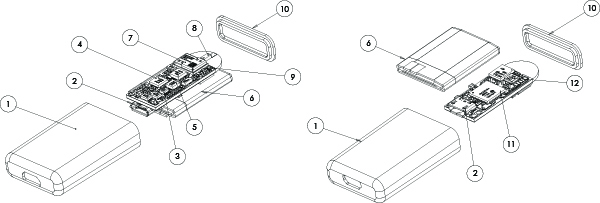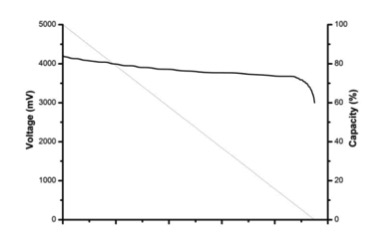Understanding your device
The WAX9 device is made from multiple components. Below is an exploded view and a description of each component:

| Item | Description | Notes |
|---|---|---|
| 1 | Outer Puck Casing | Polycarbonate |
| 2 | USB Connector | |
| 3 | Magnetometer | MAG3110 |
| 4 | Accelerometer | MMA8451Q |
| 5 | Gyro | L3G4200D |
| 6 | Li-Polymer Battery | 85mAh(Puck version) |
| 7 | Bluetooth Module | PAN1326 |
| 8 | Antenna | |
| 9 | LED | |
| 10 | Puck Lid | Polycarbonate |
| 11 | MCU | PIC24 16bit |
| 12 | Altimeter | BMP180 |
Accelerometer
The accelerometer has a variable sensitivity to allow it to be used in many applications. The selectable ranges are +/- 2 g, +/- 4 g, +/- 8 g ($g$ is the acceleration due to gravity or ~9.81 ms^-2). The user should experiment with these ranges to trade off sensitivity against dynamic range. Accelerations outside the selected dynamic range result in saturation (“clipping”) of the recorded acceleration. The dynamic range of the accelerometer has no effect on the battery life or memory constraints. Table 2 shows a typical use case for each of the available sensitivities.
| Sensitivity | Example Use Case |
|---|---|
| ±2g | Fine movements such as hand writing or painting |
| ±4g | Mild activities such as walking |
| ±8g | Moderate activities such as sprinting & jumping |
Gyro
The gyro has a configurable sensitivity to allow it to be used in a wide range of applications. The gyro measures angular velocity (ω in ˚/second) of the item or body part is attached to. As the gyro has a fixed number of bits over its range, the sensitivity should be as low as possible without clipping so that the most information is captured about the object/body part.
Magnetometer
The magnetometer has a configurable range to allow it to be used in a wide range of applications. For an example application note on using the magnetometer in conjunction with a accelerometer to achieve a digital compass, please consult this application note
Barometric Pressure
The pressure is expressed as a signed 32bit integer in Pascal’s (SI unit). Conversion from Pascal’s to altitude is a complicated process involving thermodynamic and physical models to account for the changes in density and pressure through the atmosphere. However, a simple conversion can be accomplished assuming typical conditions to reasonably accurately determine a change in altitude from a given reference point at which the pressure is known ($P_0$). The conversion is explained here and can be summarised as: $$\delta_h \approx K.ln\frac{P}{P_0}$$ where $\delta_h$ is the change in height, $P$ is the pressure in Pascal’s and $P_0$ is the pressure at the origin (e.g. Sea level). $$K = -\frac{RT_0}{gM}$$ where $R$ is the universal gas constant, $T_0$ is origins temperature, $g$ is gravity and $M$ is the molar mass of air (all SI units). Typically $K$ ≃ -8434.6678
Additional Sensors
To use the raw temperature values the user must convert the values into ˚C using the following equation: $$T = \frac{counts}{10}$$
Battery
The WAX9 has a high energy density lithium polymer cell which is used as the power source whilst gathering data. The lithium polymer battery is rated at 500 recharge cycles; battery empty to battery full. Battery charging is via a high performance charge controller that permits a full recharge of the battery within ~90 minutes.
The battery output is in millivolts and the fully charged voltage of lithium polymer cells at 25̊C is 4.2V or 4200mV. The discharge curve of lithium batteries is non-linear and it is not possible to linearly approximate the percentage of capacity remaining. After 3300mV the battery is nearly depleted (see below) and the voltage will drop rapidly, this could result in a device reset and an unexpected loss of communication; by this point the user should be recharging the device.
